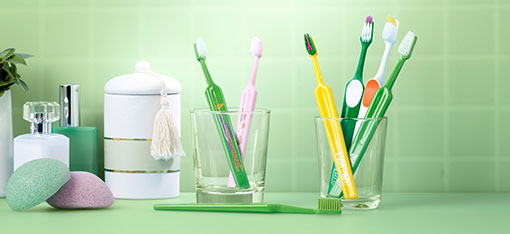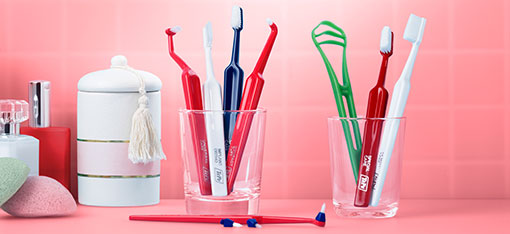Your Teeth
Give your teeth a few minutes of attention every day and you can keep them for a lifetime. Here in our Tips & Advice section you can read more about common oral health topics and get advice for your special oral hygiene needs.
Choose your topic from the menu below.
Wisdom Teeth
Treat your wisdom teeth wisely
The wisdom teeth emerge in the very back of the mouth and usually appear between the ages of 18 and 26. Some have all four wisdom teeth, others have less or none.
What is a wisdom tooth?
Wisdom teeth are the teeth that emerge in the very back of the mouth. Sometimes they stay embedded in the bone and don’t erupt. Some people don’t have wisdom teeth at all.
Common problems with wisdom teeth
A wisdom tooth which emerges slowly may be partially covered by gum tissue, making proper cleaning more difficult. When bacteria build up around the tooth, inflammation and as a result a swelling may occur.
A wisdom tooth can cause trouble by growing in the wrong direction and get trapped behind the adjacent tooth. If the problems are recurrent or if the wisdom tooth is at risk of damaging the adjacent tooth, the wisdom tooth may have to be extracted. Contact your dental professional if you experience pain in or around a wisdom tooth.
How to take care of your wisdom teeth
TePe Nova, a toothbrush with an accentuated brush tip, makes it easier to clean an erupted wisdom tooth. However, it can be challenging to clean an erupting wisdom tooth with a regular toothbrush. To make cleaning easier you can use a single tufted special brush with an angled neck, for example, TePe Compact Tuft™. Use a toothbrush with a tapered brush head for good access in the back of the mouth If discomfort remains or the swelling continues, seek advice from your dental professional
What can I do to relieve any discomfort?
It can be difficult to keep away bacteria from your emerging wisdom teeth. The right brushing technique and the right brush can prevent inflammation. Antibacterial gel can also help to reduce the inflammation around the wisdom teeth. If the problems continue, consult your dental professional for advice.
Cavities
Caries
Dental caries is one of the most common oral diseases. Caries, also known as tooth decay or cavities.
What are cavities?
Cavities are caused by the acid produced by bacteria in dental plaque. Over time the acid dissolves the tooth’s hard tissues (enamel and dentine). Initially, the cavity is limited to the enamel but when decay progresses and reaches the inside of the tooth, the dentine, a filling is usually required.
Causes of Cavities
Every time you eat or drink, bacteria in your mouth start to produce acids which dissolves part of the tooth’s hard tissue Your saliva helps by washing away excess food and neutralizes the acid. Minerals from the saliva and fluoride toothpaste repair the damaged hard tissue. Sweet food and drinks, frequent snacking between meals or a poor oral hygiene leads to increased acid production by the bacteria. This higher and frequent acid production will not give the tooth a chance to recover between meals and a cavity can develop. Good oral hygiene is necessary to prevent dental plaque build-up , but fluoride and diet are equally important factors in the development of tooth decay.
How to prevent caries
1. Brush your teeth and use fluoride toothpaste twice a day. Fluoride strengthens the tooth enamel and can heal early signs of tooth decay. Remember to also clean between your teeth once a day.
2. Frequent snacking between meals will not give your teeth the chance to recover from the acid attacks. Let your teeth rest and choose water when thirsty instead of sweet or sour drinks.
3. Always go to bed with clean teeth – the production of saliva is reduced at night, which lowers the saliva’s effectiveness.
If you suffer from dry mouth, the risk of decay is higher. Your oral hygiene is even more important as there is less saliva to help clean the teeth and neutralize the acid.
5. In addition to your daily home care, visit your dentist or dental hygienist regularly.
Interdental cleaning for children
Cleaning between the teeth is usually not recommended until all the permanent teeth have emerged completely. If your dentist or hygienist has advised you to start cleaning between the teeth earlier than that, you should, of course, follow this recommendation.
Sensitive Teeth
How to handle sensitive teeth
If you have sensitive teeth you may feel a sudden pain or discomfort, which often occurs when eating or drinking something cold, sweet or sour.
How to handle sensitive teeth
If you have sensitive teeth you may feel a sudden pain or discomfort, which often occurs when eating or drinking something cold, sweet or sour.
What causes sensitive teeth?
Sensitive teeth, or dentine hypersensitivity, can be temporary or permanent. The problems can sometimes be caused by cracks or cavities in the teeth, but predominantly sensitivity comes from exposed root surfaces. An incorrect toothbrushing technique may cause gum recession and as well as gum disease (periodontitis) which can leave the root surfaces exposed and sensitive. The most common reason for sensitive teeth is exposed root surfaces caused by incorrect brushing technique or a too hard toothbrush. There are also other causes of sensitive teeth, such as gum recession caused by, cavities, grinding and clenching.
Cleaning advice for sensitive teeth
Use a toothbrush with extra-soft or soft filaments and a toothpaste for sensitive teeth with fluoride. For gentle cleaning between the teeth, use a TePe interdental brush with soft filaments. If the problems remain more than a week, seek advice from your dental profession.
Brushing your sensitive teeth
The right toothbrushing technique can ease sensitivity. Gentle brushing using fluoride toothpaste is key.
Cleaning Between Your Teeth
What is Interdental Cleaning?
Most people know to brush their teeth at least twice a day and floss once a day to keep their mouth fresh, clean, and healthy. But your toothbrush can only reach the inside, outside, and biting side of your tooth.
Even the best toothbrush can’t reach between the teeth like floss. And even the best quality floss can’t properly brush the side of your teeth like a toothbrush can.
Don’t forget to efficiently clean the surfaces between your teeth every day. When forgotten and left undisturbed, bacteria can multiply in these hard-to-reach zones.
Think of it this way - would you brush only half of your hair before heading out in the morning? Maybe that sounds silly, but so many people do the equivalent with their teeth!
How to clean between the teeth
There are different interdental cleaning devices such as floss, dental picks or interdental brushes. An interdental brush is the most efficient tool to keep your teeth healthy and prevent gum inflammation and cavities. What product you need is dependent on your individual needs and preferences. Ask you dental professional for advice. Read our instruction on how to clean between your teeth with TePe Interdental Brushes.
Daily Oral Care
There are several ways of cleaning between your teeth, depending on the size of your gaps and what you prefer yourself. In large gaps the most effective method is to use an interdental brush.
TePe offers interdental brushes in nine sizes to fit different interdental spaces.
TePe EasyPick™ is an easy and efficient option for cleaning between your teeth (It is convenient to bring along and use on-the-go).
Dental floss can be effective and is often a good option in the late teens when the spaces between the teeth are usually very tight or small. A preloaded floss holder, TePe Mini Flosser™, is an easier way of flossing.
Interdental cleaning for children
Cleaning between the teeth is usually not recommended until all the permanent teeth have emerged completely. If your dentist or hygienist has advised you to start cleaning between the teeth earlier than that, you should, of course, follow this recommendation.
Care for Your Dental Implants
How to care for your dental implants
Care for your dental implants just as well as you would care for your natural teeth. Thorough oral hygiene is necessary to prevent diseases to develop around the implants. With proper home care and regular professional maintenance, you can make your new teeth last throughout life. There are various types of implants which may need different home care.
TePe offers a range of products to make cleaning easier. Your dental professional will help you choose the products to suit your particular needs and preferences.
Mucositis (gum inflammation around implants) and peri-implantitis (bone-loss around implants) is caused by dental plaque. Therefore, it is important to clean all implant surfaces, especially between implants and the adjacent tooth. Pay extra attention to the areas where gums and implant meet. Sometimes this can be hard to see where the implant is, so remember to ask your dental professional exactly where your implants are placed. In case of pain or suspected inflammation, a dental professional should be consulted as well.
Brushing Teeth
How to brush your teeth
The right technique for brushing your teeth is essential for keeping your teeth and gums healthy. It is also important to choose a high-quality toothbrush with a design that suits your individual needs and preferences.
Gentle and efficient toothbrushing
If the toothbrush filaments are too hard or if you use the wrong brushing technique, your gums or teeth may be damaged. Choose a toothbrush with soft filaments and a tapered brush head to enable better access to the back teeth. Remember to change your toothbrush when the filaments become worn. A worn toothbrush does not clean your teeth properly. All TePe's toothbrushes have tapered heads and come in different filament textures. They are efficient, durable and user-friendly.
How to brush your teeth
The right toothbrushing technique is essential to keep your gums and teeth healthy. Brush the inside, outside and biting surfaces of the teeth with a toothbrush and fluoride toothpaste twice a day for at least two minutes. Angle the toothbrush at 45° so that the filaments reach the gum line. Brush with light pressure and small movements.
2-2-2 rule
• Use 2 cm of fluoride toothpaste
• Brush 2 times a day
• Brush for 2 minutes
Care for Your Braces
Home care for braces
Wearing braces can make dental care slightly more complicated. To prevent gum disease and cavities, you need to clean both your teeth and braces properly. Cleaning with a regular toothbrush is not enough – you often need additional cleaning products . Your dentist/orthodontic assistant can guide you to suitable products for orthodontic care and show you how to use them. If you have removable braces, make sure to brush them too, using a toothbrush and water.
How to clean your braces
Start by rinsing your mouth with water, to loosen food debris that has been trapped around the wire.
Then clean the teeth and braces with a toothbrush using small circular motions. Don’t forget to angle the brush towards the gum line.
Finish by brushing the inside and chewing surfaces.
To get a good result, you will need to clean where the toothbrush cannot reach. A small toothbrush with a round head is useful for cleaning around the brackets and gum line. An interdental brush will help clean under the wire and between the teeth.
If you have removable braces, make sure to brush them daily, using a toothbrush and water.
Four tips to keep your mouth healthy during orthodontic treatment
1. Brush with fluoride toothpaste
2. Use interdental devices
3. Clean your teeth and braces after each meal
4. Use a fluoride rinse to minimize the risk of tooth decay
Help your child deal with braces
Getting used to braces can be a struggle. Initial discomfort and pain is common, and the new look can take a while to accept. Here is some advice to help your child adjust:
1. Discuss the benefits of treatment with your child
2. Help with the cleaning of the braces
3. Stock up with orthodontic wax
4. Serve soft food to start
5. Prepare a travel case with special brushes for your child to bring to school
Children's Dental Care
How to brush your kids teeth
Children need help and supervision to brush from the first tooth until the age of 10-12. A small child does not have the manual skills to brush properly and is not able to understand the consequences of not brushing correctly.
Six tips for brushing children's teeth
1. Brush twice a day. Brush once in the morning and once at night before bedtime.
2. Use a small and soft brush. The toothbrush should have a small brush head and gentle filaments.
3. Apply a little toothpaste. Use the size of the child’s little finger nail.
4. Create a habit. Brush the inside, outside and biting surfaces in the same order to make sure no side is forgotten.
5. Remember the gum line. Place the filaments at a 45º angle towards teeth and gum line.
6. Be gentle. Brush with a slight pressure using small movements.
How to brush your baby’s teeth
It is time to start brushing your children´s teeth as soon as the first tooth emerges. A fixed routine, in the morning and before bedtime, makes toothbrushing a natural part of your child's day. It’s often convenient to brush with your child lying down, head nearest to you, for example, on the changing table. Closeness and eye contact make the child feel secure. While brushing, gently lift the child’s lip with your finger to see and reach better. With TePe Mini™ it’s easy to start brushing from the very first tooth. It’s recommended for children from 0 to 3 – 4 years of age.
How to brush your kids’ teeth – pre-school children
Let the child sit in your lap, leaning the head on your arm. Brush with short movements and be sure that the toothbrush reaches the gum line. Always brush in the same order, for example, the inside, the outside and then the chewing surfaces of the teeth. To reach all surfaces it helps to lift the child’s lip gently with your finger. After 3-4 years of age, you could start using a toothbrush with a slightly bigger brush head, like TePe Select Compact™. This brush is also available with cute prints – ask for TePe Kids™.
How to brush your kids’ teeth – school children
Supervise and help your child to brush until the age of 10 -12. Brush with short movements and be sure that the toothbrush reaches the gum line. Always brush in the same order, for example, the inside, the outside and then the chewing surfaces of the teeth. Give some extra attention to the new molars which emerge behind the last milk teeth. Their chewing surfaces are irregular and extra sensitive to cavities. Use a special brush, for example, TePe Compact Tuft™, as a complement to the regular toothbrush. TePe Select Compact™ is a popular choice.
When it’s time to brush yourself
At 10-12 years of age, it’s time for your child to use the brush him/herself, but it is, of course, possible to start practicing earlier. In the beginning, your child may have to brush under your supervision. From the age of 12, TePe Select™ is a good choice of toothbrush. It’s also available with illustrations – ask for TePe Graphic™.
2. Aging Population
• Learn about TePe as a company with a brief introduction of TePe’s product portfolio
• Discuss the importance of oral health for the aging population
• Explore suitable TePe products for the aging population
• Discuss resources to use chairside with patients and how to access products
3. Children's Teeth
• Learn about TePe as a company with a brief introduction of TePe’s product portfolio
• Discuss the importance of oral health for children
• Explore suitable TePe products for children
• Discuss resources to use chairside with patients and how to access products
4. Orthodontic Care
• Learn about TePe as a company with a brief introduction of TePe’s product portfolio
• Discuss the importance of oral health during orthodontic treatment
• Explore suitable TePe products during orthodontic treatment
• Discuss resources to use chairside with patients and how to access products
5. Sustainability
• Learn about TePe as a company with a brief introduction of TePe’s product portfolio
• Explore what sustainability means at TePe
• Understand TePe’s journey to sustainable change
• Summarize the benefits of pursuing sustainable products










